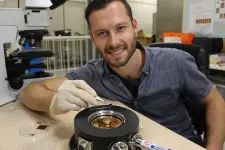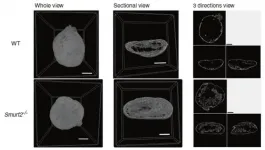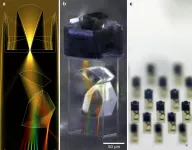(Press-News.org) An international team of scientists has invented the equivalent of body armour for extremely fragile quantum systems, which will make them robust enough to be used as the basis for a new generation of low-energy electronics.
The scientists applied the armour by gently squashing droplets of liquid metal gallium onto the materials, coating them with gallium oxide.
Protection is crucial for thin materials such as graphene, which are only a single atom thick - essentially two-dimensional (2D) - and so are easily damaged by conventional layering technology, said Matthias Wurdack, who is the lead author of the group's publication in Advanced Materials.
"The protective coating basically works like a body armour for the atomically-thin material, it shields against high-energy particles, which would cause a large degree of harm to it, while fully maintaining its optoelectronic properties and its functionality," said Mr Wurdack, a PhD student in the Nonlinear Physics Centre (NLPC) of the Research School of Physics, and the FLEET ARC Centre of Excellence.
The new technique opens the way for an industry based on ultra-thin electronics to expand, said leader of the research team, Professor Elena Ostrovskaya, also from NLPC and FLEET.
"Two-dimensional materials have extraordinary properties such as extremely low resistance or highly efficient interactions with light."
"Because of these properties they could have big role in the fight against climate change."
Eight percent of global electricity consumption in 2020, was due to information technologies, including computers, smartphones and large data centres of tech giants such as Google and Amazon. That figure is projected to double every decade as demand for AI services and smart devices skyrockets.
However, this work promises lower-energy alternatives for electronics and optoelectronics, by harnessing the superior performance of 2D semiconducting materials, such as tungsten disulphide, which was used in this study.
Using 2D materials to make more efficient devices will have advantages beyond reduced carbon emissions, says Mr Wurdack.
"2D technology could also enable super-efficient sensors on space craft, or processors in Internet of Things devices that are less limited by battery life."
The team created their protective layer by exposing to air a droplet of liquid gallium, which immediately formed a perfectly even layer of gallium oxide on its surface a mere three nanometers thick.
By squashing the droplet on top of the 2D material with a glass slide, the gallium oxide layer can be transferred from the liquid gallium onto the material's entire surface, up to centimetres in scale.
Because this ultrathin gallium oxide is an insulating amorphous glass, it conserves the optoelectronic properties of the underlying 2D semiconductor. The gallium oxide glass can also enhance these properties at cryogenic temperatures and protects well against other materials deposited on top. This allows the fabrication of sophisticated, layered nanoscale electronic and optical devices, such as light emitting diodes, lasers and transistors.
"We've generated a nice alternative to existing technology that can be scaled for industry applications," Mr Wurdack said.
"We hope to find industry partners to work with us to develop a protective layer printer based on this technology, that can go into any lab, like a lithography machine."
"It would be exciting to see fundamental research like this find its way into industry!"
INFORMATION:
THE STUDY
Ultrathin Ga2O3 Glass: A Large-Scale Passivation and Protection Material for Monolayer WS2 was published in Advanced Materials in December 2020. DOI 10.1002/adma.202005732
A framework designed to provide detailed information on agricultural groundwater use in arid regions has been developed by KAUST researchers in collaboration with the Saudi Ministry of Environment Water and Agriculture (MEWA).
"Groundwater is a precious resource, but we don't pay for it to grow our food, we just pump it out," says Oliver López, who worked on the project with KAUST's Matthew McCabe and co-workers. "When something is free, we are less likely to keep track of it, but it is critical that we measure groundwater extraction because it impacts both food and water security, not just regionally, but globally."
Saudi Arabia's farmland is often irrigated via center pivots that tap underground aquifer sources. The team has built a powerful tool ...
Osaka, Japan - Bone morphogenetic protein (BMP) has a strong osteogenic (bone forming) ability. BMP has already been clinically applied to spinal fusion and non-union fractures. However, dose-dependent side effects related to BMP use, such as inflammatory reactions at the administration site, prevent widespread use.
For safe use, it was necessary to clarify how the BMP signaling pathway is controlled. In a report published in Bone Research, a group of researchers from Osaka University and Ehime University has recently identified a novel role for the protein Smurf2 in regulating bone formation by BMP.
When BMP transmits its message within cells, it can induce rapid bone formation. Previous studies have shown that Smurf2 can control another similar ...
Lithium metal batteries could double the amount of energy held by lithium-ion batteries, if only their anodes didn't break down into small pieces when they were used.
Now, researchers led by Prof. CUI Guanglei from the Qingdao Institute of Bioenergy and Bioprocess Technology (QIBEBT) of the Chinese Academy of Sciences (CAS) have identified what causes lithium metal batteries (LMBs) to "self-destruct" and proposed a way to prevent it. The findings were published in Angewandte Chemie on Jan. 19.
This offers hope of radically enhancing the energy held in batteries without any increase in their size, and at reduced cost.
In fact, LMBs were the original concept for long-lasting ...
Tiny nanoparticles can be furnished with dyes and could be used for new imaging techniques, as chemists and physicists at Martin Luther University Halle-Wittenberg (MLU) show in a recent study. The researchers have also been the first to fully determine the particles' internal structure. Their results were published in the renowned journal Angewandte Chemie.
Single-chain nanoparticles (SCNPs) are an attractive material for chemical and biomedical applications. They are created from just a single chain of molecules that folds into a particle whose circumference measures three to five nanometres. "Because they are so small, they can travel everywhere in the human body and be used for a wide variety of purposes," says Professor Wolfgang ...
In humans, differences in personalities have been evident since the ancient times. Personality in animals has long been ignored, but recently this question has received increasing research interest as it has been realized that personality has evolutionary and ecological significance. An international team of behavioral biologists from Austria, Brazil and the Netherlands, with Vedrana Å lipogor from the University of Vienna as leading author of the study, designed a set of tasks to assess personality of common marmosets. These results have just been published in American Journal of Primatology.
Marmosets are small highly social New World monkeys that parallel humans in their social organization, as they live in cohesive ...
Researchers from the Institute of Environmental Science and Technology of the Universitat Autònoma de Barcelona (ICTA-UAB) warn of the impact the current tourism model in the Mediterranean islands has on the production of marine litter on beaches, and recommend taking advantage of the situation generated by the Covid19 pandemic to rethink a new more sustainable model. The research, recently published in the journal Scientific Reports, shows that the recreational use of Mediterranean island beaches during the summer is responsible for up to 80% of the marine litter accumulating on those beaches, and generates huge amounts of microplastics through the fragmentation ...
A German-Chinese research team has found a new synthetic route to produce biofuel from biomass. The chemists converted the substance 5-hydroxymethylfurfural (HMF) produced from biomass into 2,5-dimethylfuran (DMF), which could be suitable as a biofuel. Compared to previous methods, they achieved a higher yield and selectivity under milder reaction conditions. The team led by Dr. Baoxiang Peng and Professor Martin Muhler from the Laboratory of Industrial Chemistry at Ruhr-Universität Bochum (RUB) and the group led by Professor Christof Hättig from the RUB Chair for Theoretical Chemistry described the method together with colleagues from Changzhou, ...
Solar energy is one of the most abundant renewable energy sources, and effective solar technologies have great potential to alleviate the grand challenges of rising global energy demands, while reducing associated emissions. Solar energy is capable of satisfying the electrical and thermal-energy needs of diverse end-users by means of photovoltaic (PV) and solar thermal (ST) technologies, respectively. Recently, hybrid photovoltaic-thermal (PVT) concepts have been proposed that synergistically combine the benefits of PV and ST technologies, and are capable of generating both electricity and useful heat simultaneously from the same area and component.
Spectral splitting is an emerging approach for designing high-performance PVT solar collectors, which employ advanced designs ...
The molecular details of how SARS-CoV-2 enters cells and infects them are still not clear. Researchers at Uppsala University have tested the bioinformatic predictions made by another research group and have identified receptors that could be important players in the process. The results are presented in the journal Science Signaling and at the AAAS Annual Meeting held this week.
The spike protein of SARS-CoV-2 binds the protein ACE2 on the outside of the human cell. This triggers a series of events that leads to invasion of the cell by the virus. The molecular details of this process have remained obscure ...
Femtosecond direct laser writing as a 3D printing technology has been one of the key building blocks for miniaturization in modern times. It has transformed the field of complex microoptics since the early 2000s. Especially medical engineering and consumer electronics as vastly growing fields benefit from these developments. It is now possible to create robust, monolithic and nearly perfectly aligned freeform optical systems on almost arbitrary substrates such as image sensors or optical fibers.
Simultaneously, the miniaturisation of spectroscopic measurement devices has been advanced, for instance based on quantum dot or nanowire technology. These are based on computational approaches, which have the drawback of ...






